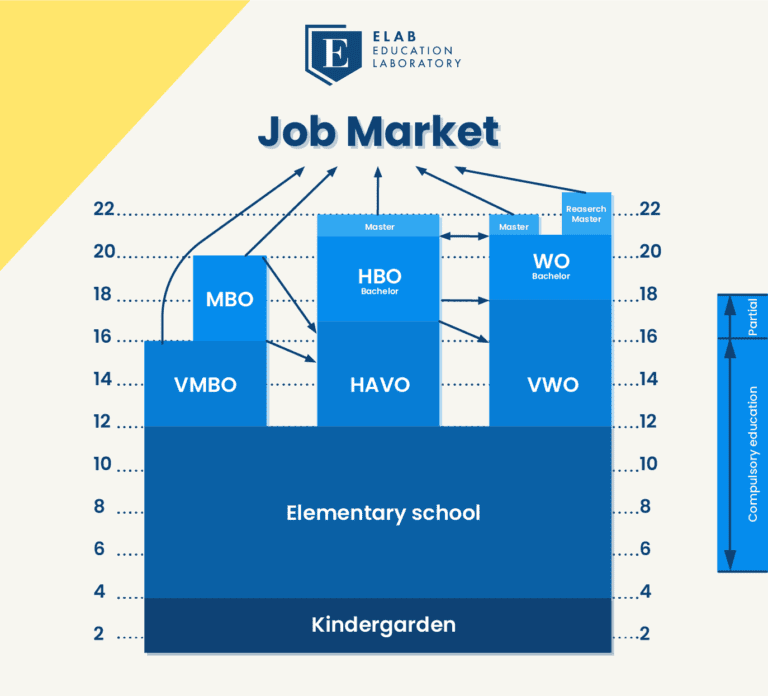
Education system in the Netherlands all you need to know
The Dutch education system. The Dutch education system is a strong performer, with outcomes for cognitive skills that are both strong on average and in terms of equity. These outcomes emerge from a system that balances a high level of decentralisation and school autonomy with a strong set of accountability measures.

UK education system Uk education system, Uk education, Education system
The education system in the Netherlands begins with kindergarten and, by the age of four or five, children have moved to Stage 1 -elementary school- where they will spend the next seven to eight years. Full-time education is compulsory from 5-16, and from 16-18 young people must attend some form of school for at least two days a week.

Grade Indications Dutch International Schools
A description of the Dutch education system. Basic information. Level of Dutch diplomas Educational institutions and study programmes Grading systems Chart: education system in the Netherlands Extended information. Primary and secondary education Secondary vocational education
Dutch and German school system compared
From this, the question of how Dutch parents abroad experience schools abroad arose naturally. More than 60 Dutch parents living abroad signed up and eventually, 57 families participated. . In this study, Dutch for Children looked at how Dutch children learn abroad. We also looked at how the education system pleases parents living abroad.

Dutch educational system. Source Center of International Education... Download Scientific Diagram
Educational policy is coordinated by the Dutch Ministry of Education, Culture and Science with municipal governments. Compulsory education ( leerplicht) in the Netherlands starts at the age of five, although in practice, most schools accept children from the age of four. From the age of sixteen there is a partial compulsory education.

1 The Dutch school system Download Scientific Diagram
There are more and more bilingual secondary schools. At these schools at least 50% of the subjects are taught in English. The children speak English during for instance geography or history lessons, or during physical education. The schools still follow the Dutch curriculum and the children need to take the Dutch school-leaving exams.

Dutch education system Summary
This means that besides theoretical knowledge, the student will get practical hands on experience through internships, group work and so on. In other countries 'hbo' is either called Polytechnic (University) or University of Applied Sciences. This type of education can be found mainly in European countries such as Belgium, the Netherlands.

What is the Dutch grading system like? ASK UvA YouTube
The Netherlands universities grading system. The traditional grading system in the Netherlands is from 1 to 10, where 1 is the lowest and 10 is the highest grade. The minimum passing mark is decided upon by the university and might vary between 4 and 6. On final lists, grades are normally rounded off (above 0,5 is rounded up and below 0,5 is.

The Dutch School System explained YouTube
Primary education in the Netherlands . In the Netherlands, there is a distinction between openbare and bijzondere schools. The openbare schools are both funded and run by an independent foundation that was originally set up by the government. They are always non-religious. About two-thirds of the population attend bijzondere (special) schools, which have their own board and often follow.

The Dutch school system for dummies a guide from one parent to another (2022)
According to Dutch law, attending school is obligatory in the Netherlands for all children aged 5 to 16 - or longer, until a basic qualification ( startkwalificatie) is gained. However, most children start primary school at age 4. Homeschooling is possible, but the process to arrange this is complex and it's very rare in the Netherlands.

1 The Dutch school system Download Scientific Diagram
In Netherlands, the average actual salaries of 25-34 year-old lower-secondary school heads is relatively high compared to OECD and partner countries with available data. (89293 USD Equivalent, rank 4/17 , 2022) Download Indicator. The average actual salaries of 55-64 year-old lower secondary school heads is one of the highest in Netherlands.
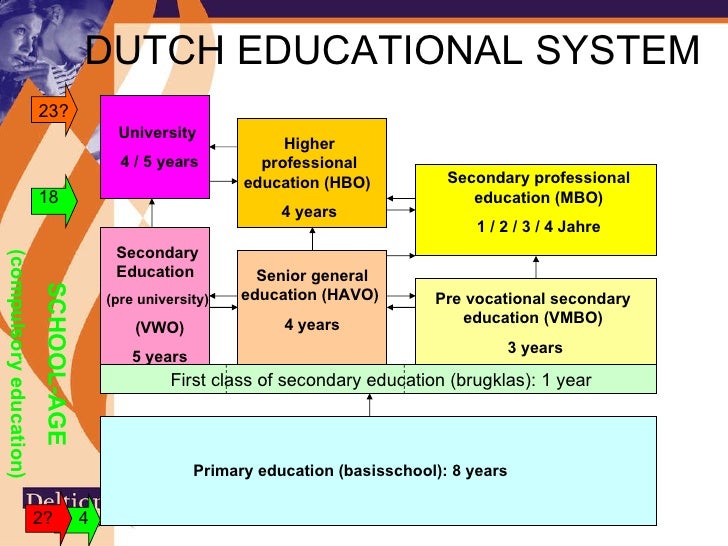
The Netherlands presentation
OECD Indicators. Education at a Glance is the authoritative source for data on the state of education around the world. It provides information on the structure, finances and performance of education systems across OECD countries and partner economies. More than 100 charts and tables in this publication - as well as much more data available.
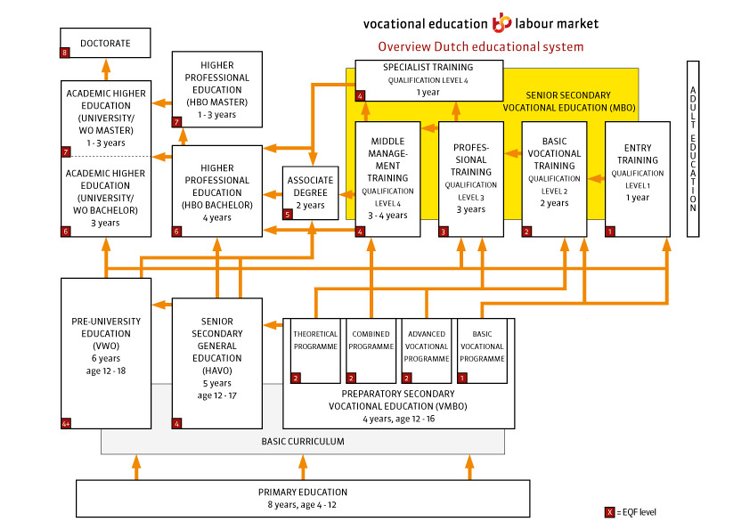
Dutch school system / Dutch levels of education
In the first two years, kleuters (four and five-year-olds) are guided through a gradual transition from learning-by-playing to learning to read and write. In practice, this means that some children (those born in the summer or autumn) have a full two years at school before they go into group three (the "late" pupils). Ad by Refinery89.

The Dutch Education System Download Scientific Diagram
duration i. of study programmes via: Primary and secondary education. Secondary vocational education. Higher education. Are you blind or partially sighted? We can send you a short description of what this chart contains. Please contact us. In this chart you can see how the Dutch education system is organised.
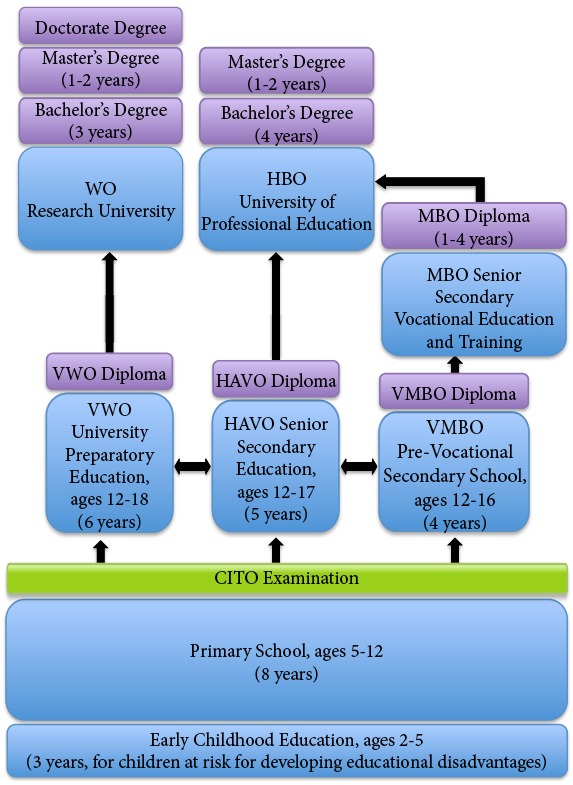
NCEE Netherlands Overview
Cost may also be a factor; some international schools are partly subsidised and have annual fees of around €5,500 per child, while private international schools can cost €12,000 to €24,000 per child annually. The subsidised schools will usually have a much longer waiting list than fully private schools. Find out about choosing between a.

Description of the Dutch educational system. Source Statistics... Download Scientific Diagram
Perhaps one of the simplest questions to answer is that of cost. Dutch schools are government-funded. Parents may be asked to pay a small (voluntary) contribution. In regards to international schools, some are partly subsidised, resulting in fees of around €5,500 per child. Private international schools can cost €12,000 to €24,000 per child.